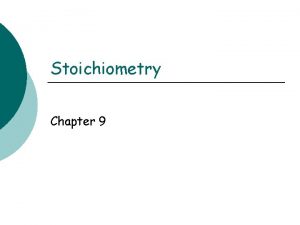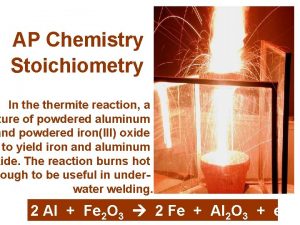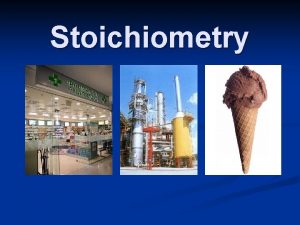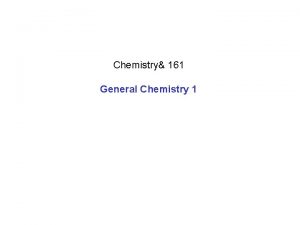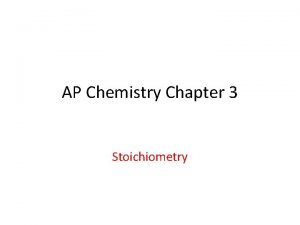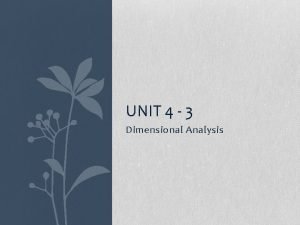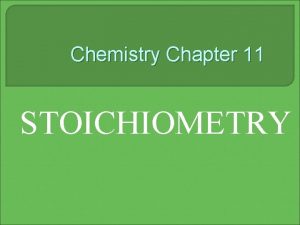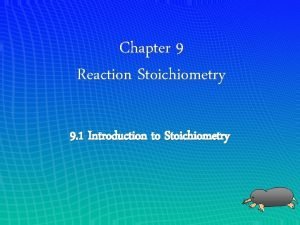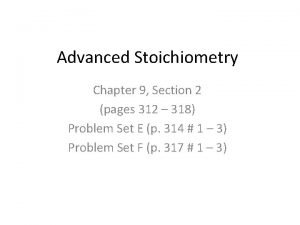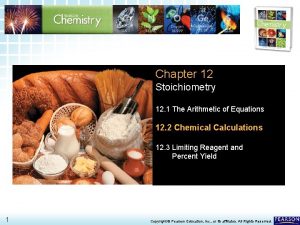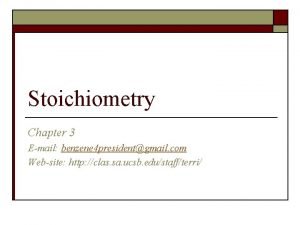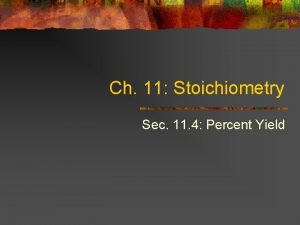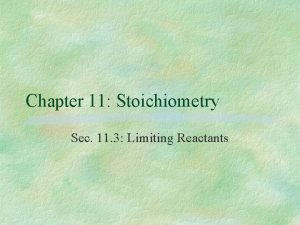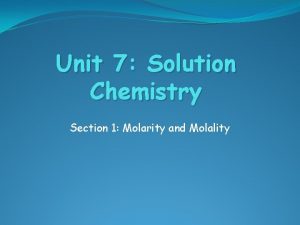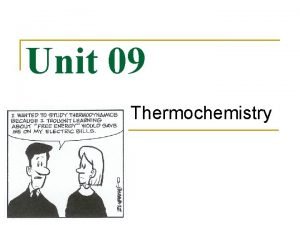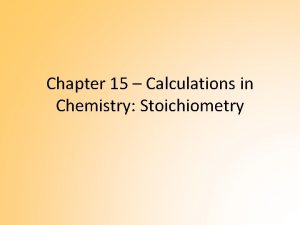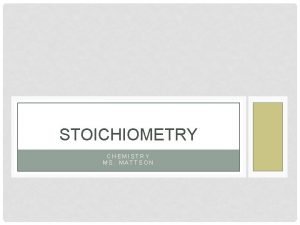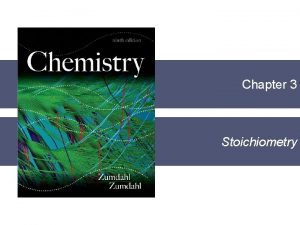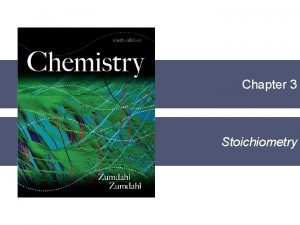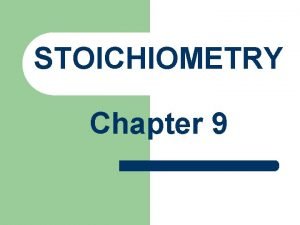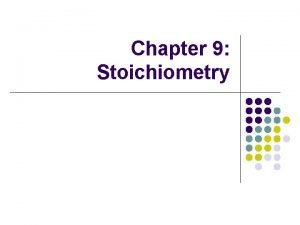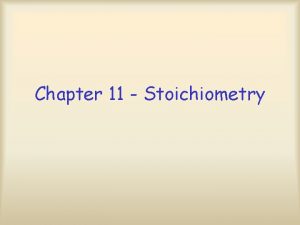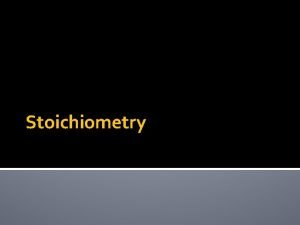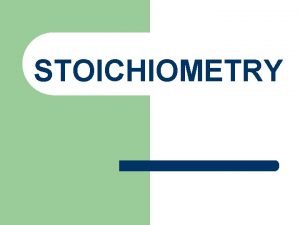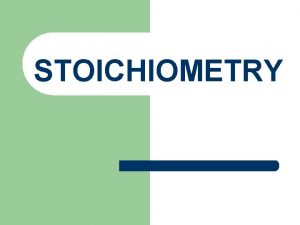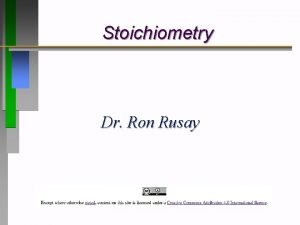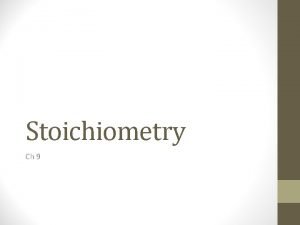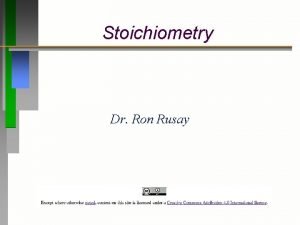AP Chemistry Unit 3 Stoichiometry Day 1 Chapter









































- Slides: 41

AP Chemistry Unit 3 – Stoichiometry Day 1: Chapter 3 Notes

Warm Up • Balance the following equation. Why must we do so? __CH 4(g) + 2 O 2(g) ___CO 2(g)+ 2 H 2 O(g)

Agenda • Lecture: Review Chapter 3 ▫ ▫ Types of Reactions Percent Composition Empirical Formulas Molecular Formulas • Guided Inquiry: Chemical Equations • Progress Reports and One-on-One Meetings NEXT CLASS: • Guided Inquiry DUE • Determining the Mole Ratios in a Chemical Reaction

Stoichiometry • The study of the mass relationships in chemistry • Based on the Law of Conservation of Mass (Antoine Lavoisier, 1789) “We may lay it down as an incontestable axiom that, in all the operations of art and nature, nothing is created; an equal amount of matter exists both before and after the experiment. Upon this principle, the whole art of performing chemical experiments depends. ” —Antoine Lavoisier

Chemical Equations Chemical equations are concise representations of chemical reactions.

What Is in a Chemical Equation? CH 4(g) + 2 O 2(g) Reactants appear on the left side of the equation. CO 2(g) + 2 H 2 O(g)

What Is in a Chemical Equation? CH 4(g) + 2 O 2(g) CO 2(g) + 2 H 2 O(g) Products appear on the right side of the equation.

What Is in a Chemical Equation? CH 4(g) + 2 O 2(g) CO 2(g) + 2 H 2 O(g) The states of the reactants and products are written in parentheses to the right of each compound. (g) = gas; (l) = liquid; (s) = solid; (aq) = in aqueous solution

What Is in a Chemical Equation? CH 4(g) + 2 O 2(g) CO 2(g) + 2 H 2 O(g) Coefficients are inserted to balance the equation to follow the law of conservation of mass.

Why Do We Add Coefficients Instead of Changing Subscripts to Balance? • Hydrogen and oxygen can make water OR hydrogen peroxide: • 2 H 2(g) + O 2(g) → 2 H 2 O(l) • H 2(g) + O 2(g) → H 2 O 2(l)

Three Types of Reactions • Combination reactions ▫ A + B AB • Decomposition reactions ▫ AB A + B • Combustion reactions ▫ Cx. Hy + O 2 CO 2 H 2 O

Combination Reactions • In combination reactions two or more substances react to form one product. • Examples: ▫ 2 Mg(s) + O 2(g) ▫ N 2(g) + 3 H 2(g) ▫ C 3 H 6(g) + Br 2(l) 2 Mg. O(s) 2 NH 3(g) C 3 H 6 Br 2(l)

Decomposition Reactions • In a decomposition reaction one substance breaks down into two or more substances. • Examples: ▫ Ca. CO 3(s) ▫ 2 KCl. O 3(s) ▫ 2 Na. N 3(s) Ca. O(s) + CO 2(g) 2 KCl(s) + O 2(g) 2 Na(s) + 3 N 2(g)

Combustion Reactions • Combustion reactions are generally rapid reactions that produce a flame. • Combustion reactions most often involve oxygen in the air as a reactant. • Examples: ▫ CH 4(g) + 2 O 2(g) ▫ C 3 H 8(g) + 5 O 2(g) CO 2(g) + 2 H 2 O(g) 3 CO 2(g) + 4 H 2 O(g)

Formula Weight (FW) • A formula weight is the sum of the atomic weights for the atoms in a chemical formula. • This is the quantitative significance of a formula. • The formula weight of calcium chloride, Ca. Cl 2, would be Ca: 1(40. 08 amu) + Cl: 2(35. 453 amu) 110. 99 amu

Molecular Weight (MW) • A molecular weight is the sum of the atomic weights of the atoms in a molecule. • For the molecule ethane, C 2 H 6, the molecular weight would be C: 2(12. 011 amu) + H: 6(1. 00794 amu) 30. 070 amu

Ionic Compounds and Formulas • Remember, ionic compounds exist with an order of ions (charges of ions must match up for a net charge of 0). There is no simple group of atoms to call a molecule. • As such, ionic compounds use empirical formulas and formula weights (not molecular weights).

Percent Composition One can find the percentage of the mass of a compound that comes from each of the elements in the compound by using this equation: % Element = (number of atoms)(atomic weight) (FW of the compound) × 100

Percent Composition So the percentage of carbon in ethane is (2)(12. 011 amu) %C = = (30. 070 amu) 24. 022 amu 30. 070 amu = 79. 887% × 100

Avogadro’s Number • In a lab, we cannot work with individual molecules. They are too small. • 6. 02 × 1023 atoms or molecules is an amount that brings us to lab size. It is ONE MOLE. • One mole of 12 C has a mass of 12. 000 g.

Molar Mass • A molar mass is the mass of 1 mol of a substance (i. e. , g/mol). • The molar mass of an element is the atomic weight for the element from the periodic table. If it is diatomic, it is twice that atomic weight. • The formula weight (in amu’s) will be the same number as the molar mass (in g/mol).

Using Moles provide a bridge from the molecular scale to the real-world scale.

Mole Relationships • One mole of atoms, ions, or molecules contains Avogadro’s number of those particles. • One mole of molecules or formula units contains Avogadro’s number times the number of atoms or ions of each element in the compound.

Determining Empirical Formulas One can determine the empirical formula from the percent composition by following these three steps.

Determining Empirical Formulas— an Example The compound para-aminobenzoic acid (you may have seen it listed as PABA on your bottle of sunscreen) is composed of carbon (61. 31%), hydrogen (5. 14%), nitrogen (10. 21%), and oxygen (23. 33%). Find the empirical formula of PABA.

Determining Empirical Formulas— an Example Assuming 100. 00 g of para-aminobenzoic acid, C: 61. 31 g × H: 5. 14 g × N: 10. 21 g × O: 23. 33 g × 1 mol 12. 01 g 1 mol 14. 01 g 1 mol 16. 00 g = 5. 105 mol C = 5. 09 mol H = 0. 7288 mol N = 1. 456 mol O

Determining Empirical Formulas— an Example Calculate the mole ratio by dividing by the smallest number of moles: 5. 105 mol C: = 7. 005 ≈ 7 0. 7288 mol H: 5. 09 mol 0. 7288 mol = 6. 984 ≈ 7 N: 0. 7288 mol = 1. 000 O: 1. 458 mol 0. 7288 mol = 2. 001 ≈ 2

Determining Empirical Formulas— an Example These are the subscripts for the empirical formula: C 7 H 7 NO 2

Ethanol contains 52. 2% carbon, 13. 0% hydrogen, and 34. 8% oxygen by mass. The empirical formula of ethanol is a. C 2 H 5 O 2 b. C 2 H 6 O c. C 2 H 6 O 2 d. C 3 H 4 O 2

Determining a Molecular Formula • Remember, the number of atoms in a molecular formula is a multiple of the number of atoms in an empirical formula. • If we find the empirical formula and know a molar mass (molecular weight) for the compound, we can find the molecular formula.

Determining a Molecular Formula: Example Determine the molecular formula of a compound with an empirical formula of CF 2 and a molar mass of 200. 04 g/mol STEP 1: Molar mass of Empirical Formula: C = 12. 01 g/mol x 1 = 12. 01 F = 19. 00 g/mol x 2 = 38. 00 TOTAL 50. 01 g/mol

Determining a Molecular Formula: Example Determine the molecular formula of a compound with an empirical formula of CF 2 and a molar mass of 200. 04 g/mol STEP 2: Molar masses of multiples to find a match… Multiple Formula Mass x 2 C 2 F 4 100. 02 x 3 C 3 F 6 150. 03 x 4 C 4 F 8 200. 04

Determining a Molecular Formula: Example Determine the molecular formula of a compound with an empirical formula of CF 2 and a molar mass of 200. 04 g/mol Is there a simpler way? YES!!!!

Determining a Molecular Formula: Example Determine the molecular formula of a compound with an empirical formula of CF 2 and a molar mass of 200. 04 g/mol Molar mass of molecular formula Molar mass of empirical formula

Determining a Molecular Formula: Example Determine the molecular formula of a compound with an empirical formula of CF 2 and a molar mass of 200. 04 g/mol Molar mass of molecular formula = 200. 04 = Molar mass of empirical formula 50. 01 x 4 200. 04 CF 2 x 4 C 4 F 8 4

Ribose has a molecular weight of 150 grams per mole and the empirical formula CH 2 O. The molecular formula of ribose is a. b. c. d. C 5 H 10 O 5 C 4 H 8 O 4 C 6 H 14 O 4 C 6 H 12 O 6

Pre-Lab Questions TAKE OUT: Pre-Lab Questions REVIEW: With Table/Lab Partner TIME: 4 MINUTES WHEN DONE: Be ready to share out

Progress Reports Quarter 1 Grades: Due Nov 4 VIEW: Your progress Report SHOW ME: Any missing work • Mid-Term Make Up ▫ By Tues, Oct 28 th • Homework Assignments (Book) • Cornell Notes • Revised Formal Lab Report ▫ DUE Tuesday OCT 28 th ONE-ON-ONE: 3 minutes each WHEN DONE: Work on missing work OR Chapter 3 Practice



 Day 1 day 2 day 3 day 4
Day 1 day 2 day 3 day 4 Chemistry chapter 9 stoichiometry
Chemistry chapter 9 stoichiometry Modern chemistry textbook answers chapter 9
Modern chemistry textbook answers chapter 9 Chapter 11 study guide chemistry stoichiometry answer key
Chapter 11 study guide chemistry stoichiometry answer key A balanced chemical equation allows one to determine the:
A balanced chemical equation allows one to determine the: Day 1 day 2 day 817
Day 1 day 2 day 817 Thermite reaction formula
Thermite reaction formula Stoichiometry is
Stoichiometry is General chemistry 1 stoichiometry
General chemistry 1 stoichiometry Ap chemistry stoichiometry
Ap chemistry stoichiometry Unit: stoichiometry “multi-step problems” – ws #3
Unit: stoichiometry “multi-step problems” – ws #3 Ib organic chemistry
Ib organic chemistry Inorganic chemistry vs organic chemistry
Inorganic chemistry vs organic chemistry Unit 6 review questions
Unit 6 review questions Chapter 11 stoichiometry
Chapter 11 stoichiometry Chapter 9 review introduction to stoichiometry
Chapter 9 review introduction to stoichiometry Chapter 12 stoichiometry test
Chapter 12 stoichiometry test Chapter 9 section 2 stoichiometry
Chapter 9 section 2 stoichiometry Chapter 12 stoichiometry answer key pearson
Chapter 12 stoichiometry answer key pearson Mass to mass stoichiometry formula
Mass to mass stoichiometry formula Chapter 3 stoichiometry answer key
Chapter 3 stoichiometry answer key Chapter 12 stoichiometry
Chapter 12 stoichiometry Define percent yield
Define percent yield Chapter 11 stoichiometry
Chapter 11 stoichiometry William beanes elementary
William beanes elementary Haiku and
Haiku and Day to day maintenance
Day to day maintenance As your room gets messier day by day, entropy is
As your room gets messier day by day, entropy is Tomorrow i don't know
Tomorrow i don't know Act 2, scene 4 romeo and juliet summary
Act 2, scene 4 romeo and juliet summary Growing day by day
Growing day by day Define seed dormancy
Define seed dormancy Conclusion of seed germination
Conclusion of seed germination Role of transpiration
Role of transpiration I live for jesus day after day
I live for jesus day after day Rising he justified freely forever
Rising he justified freely forever Day one day one noodle ss2
Day one day one noodle ss2 Dayone dayone noodles ss2
Dayone dayone noodles ss2 Chemistry unit 9 lesson 4
Chemistry unit 9 lesson 4 Ap chemistry thermochemistry frq
Ap chemistry thermochemistry frq Chemistry unit 7 molarity
Chemistry unit 7 molarity Q=mc∆t
Q=mc∆t

